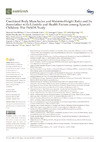Please use this identifier to cite or link to this item:
https://accedacris.ulpgc.es/handle/10553/113992
| Title: | Combined Body Mass Index and Waist-to-Height Ratio and Its Association with Lifestyle and Health Factors among Spanish Children: The PASOS Study | Authors: | Bibiloni, María del Mar Gallardo-Alfaro, Laura Gómez, Santiago F. Waernberg, J Oses-Recalde, M Gonzalez-Gross, M Gusi, N Aznar Vallejo, Eduardo Marin-Cascales, E Gonzalez-Valeiro, M Serra Majem, Luis Terrados, N Segu, M Lassale, C Homs, C Benavente-Marin, JC Labayen, I Zapico, AG Sanchez-Gomez, J Jimenez-Zazo, F Alcaraz, PE Sevilla-Sanchez, M Herrera-Ramos, E Pulgar, S Sistac, C Schroder, H Bouzas, C Tur, JA |
UNESCO Clasification: | 3206 Ciencias de la nutrición | Keywords: | Mediterranean diet Lifestyle Children Adolescents PASOS |
Issue Date: | 2022 | Project: | CB12/03/30038 Fundación PROBITAS Gasol Foundation Barça Foundation, Banco Santander, IFA, Vienna and the Fundación Deporte Joven |
Journal: | Nutrients | Abstract: | Background and Aims: The World Health Organization recommended simultaneous measurement of body mass index (BMI) and waist circumference (WC) and suggested joint use to predict disease risks. The aim of this study was to assess the prevalence of BMI and waist-to-height ratio (WHtR) categories among Spanish children and adolescents, as well as their associations with several lifestyle factors. Methods: Cross-sectional analysis of 8–16-year-old children and adolescents (n = 3772) were included in the PASOS nationwide representative study. Chil-dren/adolescents and their mothers/female caregivers answered a questionnaire on lifestyle and health factors. Child/adolescent anthropometrics were measured. Four combined BMI-WHtR disease risk categories were built. Results: A third of participants showed combined BMI-WHtR categories with high disease risk (12.3% ‘increased risk’, 9.7% ‘high risk’, 14.3% ‘very high risk’). Participants in the ‘very high risk’ group were less likely to be females (odds ratio 0.63; 95% CI: 0.52–0.76) and adolescents (0.60; 95% CI: 0.49–0.72), to practice ≥60 min/day of moderate-vigorous physical activity (MVPA) (0.73; 95% CI: 0.57–0.93), and to watch <120 min/day of total screen time on weekdays (0.61; 95% CI: 0.49–0.76). Mothers of participants in the ‘very high risk’ group were less likely to have a high educational level, be in the overweight or normal range, have never smoked or were former smokers, and watch <120 min/day of total screen time on weekends. Participants in the ‘increased’ and ‘high risk’ categories had mothers with normal weight and ≥60 min/day of MVPA. Participants in the ’high risk’ group did not achieve ≥60 min/day of MVPA and showed lower adherence to the Mediterranean diet. Conclusions: Adherence to a healthy lifestyle in children and adolescents, but also in their mothers/female caregivers during offspring’s childhood and adolescence, is associated with low BMI-WHtR disease risk. | URI: | https://accedacris.ulpgc.es/handle/10553/113992 | ISSN: | 2072-6643 | DOI: | 10.3390/nu14020234 | Source: | Nutrients [ISSN 2072-6643], v. 14 (2), 234, (Enero 2022) |
| Appears in Collections: | Artículos |
SCOPUSTM
Citations
7
checked on Jun 8, 2025
WEB OF SCIENCETM
Citations
5
checked on Jun 8, 2025
Page view(s)
105
checked on Dec 28, 2024
Download(s)
62
checked on Dec 28, 2024
Google ScholarTM
Check
Altmetric
Share
Export metadata
Items in accedaCRIS are protected by copyright, with all rights reserved, unless otherwise indicated.
